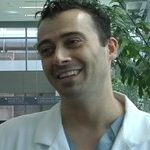
Dr. Daniel DiBardino
Hello from warm and muggy Minneapolis! Yup, it’s summer here in the upper Midwest in my hometown. Hope you’re cool and comfortable where ever you are checking in from.
Today’s topic is loosely about heart surgery and I’ll highlight one of my new surgeon colleagues at HCMC, Dr. Daniel DiBardino.
To get us started I talked a bit about heart valves in the last post which you can check out here. Since that post I had a fantastic guy on the Healthy Matters radio broadcast: Dr. Daniel DiBardino is a cardiac surgeon on the staff of Hennepin County Medical Center. This guy is not only a skilled cardiothoracic surgeon but he’s also a bit of a celebrity. And as I found, he’s the kind of guy that you warm up to in the first minute that you meet. That’s Dr. DiBardino in the picture and you can learn more about him here.
My first bit of advice is to listen to the podcast of the Healthy Matters show featuring Dr. “DiBar” – just click my face here:
I think Daniel is my first radio show guest (in nearly 8 years of broadcasts) that is also a genuine TV star. You may have heard about the TV series Boston Med which aired on ABC back in 2010. Boston Med was a real-life documentary series in which camera crews followed the action at a few of the premier hospitals in the United States. Dr. DiBardino was a surgeon at Brigham and Women’s Hospital in Boston at that time and he featured prominently in the very first episode. Totally cracks me up that his nickname on the show was “Dr. DiBar” – when you meet him it totally fits that he’d have a catchy nickname. Here is the entire first episode of Boston Med if you want to check it out:
What do heart valves do?
In my last post, which you can check out here, I talked about the basic physiology of the heart. I thought about getting into some more detail here in this post, but as I started to write more about the heart and what can go wrong, I quickly realized why it takes a a dozen years or more to become a cardiac surgeon. This is a huuuge topic so I abandoned that effort. Rather, I will simply offer a number of links for you to read more as you wish. As always, I try to provide links only to reliable sources, the Internet being a pretty tough place to separate the wheat from the chaff, so to speak.
Overview of valve disease
First, for a great and readable overview of heart valve disease, click on this page from National Heart, Lung, and Blood Institute (part of the US Government’s National Institutes of Health – or NIH – which is our country’s major route for funding quality research).
Here’s an echo (ultrasound) picture of the four chambers of the heart – you can even see the valve leaflets of the mitral valve on the right side of this picture (though in reality that is the left side of the heart . . . medical images are usually looked at backward like this!)

Aortic stenosis
One of the more common valvular diseases is aortic stenosis. The aortic valve sits between the left ventricle (the big, muscular pumping chamber) and the aorta (the biggest artery in your body and the major conduit for blood to your body). When the valve gets stenotic (or narrowed), it fails to open all the way. The heart then has to beat harder and harder and harder to get blood out to your body. This can lead to feelings of dizziness, chest pain, or shortness of breath. If untreated, it can lead to heart failure.
One in ten people over age 75 will get aortic stenosis. Yikes! The treatment is surgery and I’m happy to say surgery really works, as scary as it may sound. To understand more about aortic stenosis, watch this short video from the Alliance for Aging Research:
Aortic insufficiency and mitral insufficiency
Also known as aortic or mitral regurgitation, this is just about the opposite problem of stenosis. Valvular insufficiency is the situation where the valve fails to close all the way hence it gets leaky. As we learned elsewhere, a leaky valve means blood goes the wrong way. For more info, I recommend checking out the information from the American Heart Association here.
Random trivia since I love trivia: the mitral valve is so named because someone thought the valve looked like a bishop’s mitre (hat). Never learned that in med school!

What about the other valves?
Most heart valve problems occur in the aortic and mitral valves which are located in the high-pressure left side of the heart. There are two other valves on the lower-pressure right side. They are the tricuspid valve (so named for its three leaflets) and the pulmonic valve (which is located between the right ventricle and the pulmonary artery leading to the lungs).
These right-sided valves can also have problems and are sometimes implicated in congenital heart disease (which means problems present at birth) but they are far less likely to need replacement as adult.
Valve surgery
As we talked about with Dr. DiBardino on the radio broadcast, valve surgery can involve replacement either with a mechanical valve made from manufactured materials or a bioprosthetic (aka tissue) valve which uses tissue from animals. Both are perfectly acceptable options. A good explanation on these two types is in this video. I invite you to pay particular attention to the explanation of the differences between these 2 types of valves which starts about one minute into the video.
Dr. DiBardino
In my job I encounter all sorts of characters, and I’m just talking about the doctors! This past week was really fun hanging out with Dr. DiBardino, one of the terrific surgeons at my hospital. If you need a heart surgeon, you ought to know about this guy who practices at Hennepin County Medical Center. As always, to reach any doctor any HCMC, call 612-873-6963. Or check out HCMC.ORG. And learn more about Dr. DiBardino here.
Thanks for subscribing to MyHealthyMatters.org. What? You haven’t subscribed by e-mail? Do it today right below on this page. Don’t worry I won’t flood your inbox with too many e-mails and I will never get all commercial and try to sell you stuff.
Bye!
David

